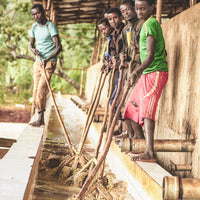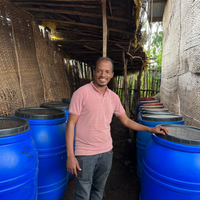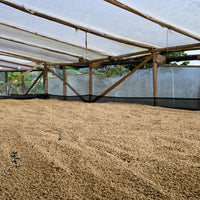Origin: Burundi
Region: Kayanza
Washing Station: Butegana
Altitude: 1612 meters above sea level
Variety: Red Bourbon
Process: 12hr LALCAFÉ CIMA™ Yeast (Saccharomyces cerevisiae) Natural
Tasting Notes: Boozy and a little winey with notes of black forest cake and dark choc cherry ripe.
Farmers delivering to Butegana washing station cultivate coffee in superb conditions of high altitudes, sunny days and cool nights. The high-quality potential of these conditions is preserved through yeast inoculated processing that emphasizes the superb quality of cherry and produces a delicious coffee.
The first coffee washing station in the country was built in 1952. It was named “Butegana”, which means “to be trapped” because Rwandan soldiers were once trapped in the valley by the Burundian army.
During the rule of King Mwambutsa, the Prince Baranyanka had the station constructed to take advantage of the abundant coffee plants in the region. Strategically, the station was built to be shared between two hills. All the station’s buildings are on one hill, Shikankoni, and all the drying tables are on the other, Nkuba.
Most coffee trees in Burundi are Red Bourbon. Because of the increasingly small size of coffee plantings, aging rootstock is a very big issue in Burundi. Many farmers have trees that are over 50 years old, but with small plots to farm, it is difficult to justify taking trees entirely out of product for the 3-4 years it will take new plantings to begin to yield. In order to encourage farmers to renovate their plantings, Greenco purchases seeds from the Institut des Sciences Agronomiques du Burundi (ISABU), establishes nurseries and sells the seedlings to farmers at or below cost. At the washing station, farmers can also get organic fertilizer from reconverted coffee pulp.
Despite the ubiquity of coffee growing in Burundi, each smallholder producers a relatively small harvest. The average smallholder has approximately 250 trees, normally in their backyards. Each tree yields an average of 1.5 kilos of cherry so the average producer sells about 200-300 kilos of cherry annually.
During the harvest season, all coffee is selectively handpicked. Most families only have 200 to 250 trees, and harvesting is done almost entirely by the family.
After sorting, cherry is placed in Epoxy-coated, concrete fermentation tanks. Cima yeast purchased from the French company Lalcafe is added to the tanks. The tanks are then covered and left to ferment for approximately 12 hours.
LALCAFÉ CIMA™ yeast (Saccharomyces cerevisiae) was specially developed for coffee production over a four-year period of research and trials. Trials in various regions and environments showed that Cima is well suited to better control the fermentation process efficiently and to upgrade the cup quality. The yeast is able to control the fermentation process and reduce the risk of spoilage micro-organisms that can generate undesirable defects. Furthermore, its specific metabolism and its high capacity, even at cold temperatures (minimum 15°C inside the coffee tank), allow for the expression of fresh and fruity characteristics, even at higher altitudes.
After fermentation is completed, cherry is transported to the drying tables where it will dry slowly for 2 to 3 weeks, during which time cherry is repeatedly sorted and sifted to ensure even drying. Cherry is left to dry from sunrise to sunset and is covered with a sheet during the evening or when it rains. The moisture level is carefully monitored and repeatedly visually inspected to remove any remaining defects or damaged beans.
Washing stations make the first payment to farmers between 15 and 30 June. The second payment comes later in the summer. If the coffee wins a competition or sells for extremely high specialty prices, Greenco gives another payment approximately a year after the harvest season.
Once dry, the parchment is bagged and taken to the warehouse. Greenco’s team of expert cuppers assess every lot (which remain separated by station, day and quality) at the lab. This level of traceability is maintained throughout the entire process.
Before shipment, coffee is sent to Budeca, Burundi’s largest dry mill. The coffee is milled and hand sorted by a team of hand-pickers who look closely at every single bean to ensure zero defects. It takes a team of two hand-pickers a full day to look over a single bag. UV lighting is also used on the beans and any bean that glows (which is usually an indication of a defect) is removed. The mill produces an average of 300 containers of 320 bags per year.
Budeca is located in Burundi’s new capital city, Gitega. The city has a population of around 30,000 people. Since there are approximately 3,000 people working at the mill, mostly as hand pickers, this means that Budeca employs nearly 10% of the total population in Gitega for at least half the year (during the milling season). The same is true in the provinces of Ngozi and Kayanza, where Greenco and Bugestal are the first employers in the region during the coffee harvest season. This has an incalculable impact on a country like Burundi, which has unemployment rates above 50%, especially in rural areas and among young people.
Burundi has long been overlooked in comparison to its neighbouring East African specialty coffee producing powerhouses. However, Burundi season, for us, is one of the highlights of the annual coffee calendar. The country’s coffee is produced almost entirely by smallholder farmers, and much of this small-scale production is of exceptional quality. With its super sweet, clean and often floral coffees, Burundi, every year, is increasingly is putting itself on the specialty coffee map.
Coffee is of paramount importance to families and the country at large. Considering this, improving and expanding coffee infrastructure is not just a way to improve incomes, it is a way to revolutionize the earning potential of an entire nation.
Building washing stations and expanding agricultural extension work can be great ways to improve coffee quality. Washing stations are pivotal in improving cup profile standards and the global reputation of Burundian coffee.
Both state-owned and private actors drive Burundi’s coffee industry and play key roles as washing station management companies and exporters. State-owned companies are called Sogestals, short for “Sociétés de Gestions des Stations de Lavage” (Washing station management companies). Privately-owned companies can operate under a variety of different names.
Sucafina’s history in Burundi goes back to 2007 when Bucafe/Sucafina Burundi was established in Bujumbura. Through Bucafe, we work with several privately-owned washing station management companies and exporters. Our work bridges the entire supply chain, allowing us to be vertically integrated. Our supply chain is solid, reliable and transparent. Due to this, we are more efficient, able to supply better value and positioned to offer both producers and consumers of Burundian coffee a diversity of expertise.







